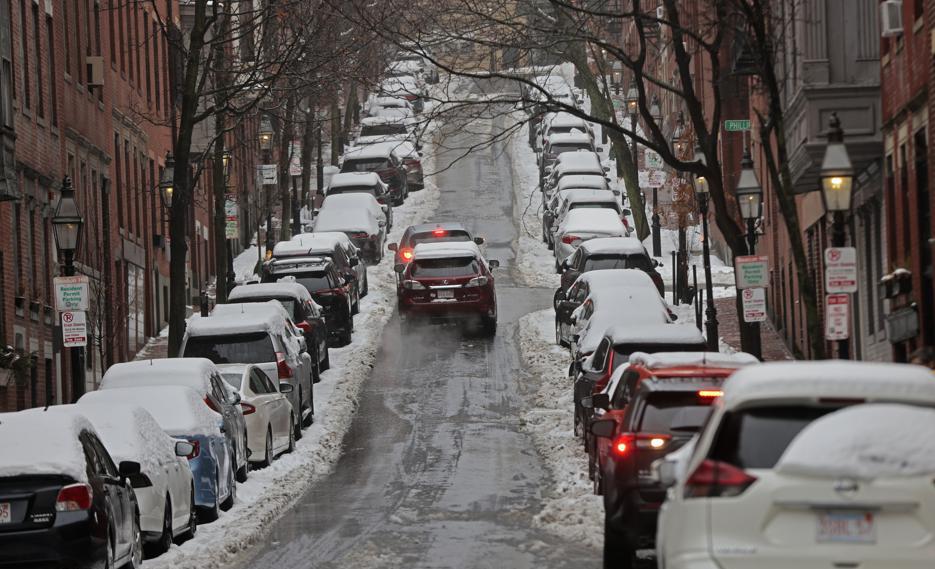
This is the second in a series of Globe stories examining New England’s changing winters.
For the first time in a while, we had a real New England winter. Sort of.
Last year, Boston only saw a paltry 9.8 inches of snow. But this year, the city has totaled nearly three times that amount — 28 inches of the white stuff — through the end of February. Better for snow lovers, but still a far cry from years past.
It’s always been a guessing game how much snow will fall in any given winter. But now, cities and towns have to contend with the added unpredictability of climate change and the financial and logistical effects of weirder, warmer weather.
From adjusting the municipal snow budget to using school snow days for heat emergencies, cities and towns are getting creative in how they adapt.
Boston City Councilor Brian Worrell, who chairs the city’s ways and means committee, said a lot of apprehension remains after Snowmageddon 2015, which dumped a little more than 8 feet of snow on the Boston area in two months. That year, the city blew past its snow management budget by nearly $20 million.
“Living in Boston, you’re always scared of what happened in 2014-2015,’’ Worrell said. “That’s always in the back of people’s minds.’’
Even so, recognizing that future winters will likely feature fewer snowstorms, the City Council elected to cut money from its snow budget for the first time this fiscal year, by more than $1.2 million.
So far this year, the move seems prudent.
Worrell said councilors came to the decision after observing how the city spent less than budgeted during four out of the past five years. The money, which funds snow equipment, including plows and salt, was reallocated to help the city pay for other “quality of life’’ initiatives, Worrell said, such as cooling centers in the summer or air conditioning at senior centers.
That said, the city is obligated, by law, to pay for snow removal, along with police overtime and legal settlements. So, if there’s a lot of snow, the city will always pay to have it removed.
Worrell said the council will likely adopt a slow, “steady decline’’ in the snow budget over time, as opposed to “a complete reallocation’’ of funds. (This year’s cut represents a roughly 5 percent decrease compared with last year.)
School districts are also weighing how best to prepare for unusual weather. Jen Myers, the community outreach specialist for Lowell Public Schools, said the district’s five snow days are used “not only as purely ‘snow’ days, but more like emergency days.’’
In 2023, it was the heat. Myers said schools in Lowell closed for two days in September due to extreme heat, using the snow days already scheduled in their academic calendar. And while some districts might consider adjusting the number of days altogether, Myers said, “Five seems like a good cushion to keep for whatever may pop up.’’
In Newton, School Committee Chair Chris Brezski said growing concerns about heat have started to dwarf stress over another potential Snowmageddon.
“We have a mix of buildings that are newer and older, air-conditioned and not air-conditioned, and that’s the piece that we’ve struggled with more,’’ he said, adding that while the district has not yet borrowed a snow day for a heat emergency, it’s not off the table in the future.
So far this year, Newton’s school district has used just one snow day, but that doesn’t mean they can take their eye off the ball.
“Unfortunately, you have to try to be prepared for all of it,’’ Brezski said.
The commonality among businesses, schools, and municipalities preparing for the winters ahead is flexibility.
Patty Nolan, a Cambridge city councilor and co-chair of the finance committee, noted that Cambridge is lucky to have a robust reserve of “free cash,’’ or unrestricted funds, it can direct to whatever priorities are most urgent in a given year. In 2015, some of that money went to snowplows and salt, but this year it could very well go to air conditioning units and cooling centers.
“If we have extreme heat events this summer as a result of the climate crisis … we’re going to have to use some of our free cash to ensure that our residents are safe,’’ she said. “We’re in the fortunate position that for now, we have some freedom to pivot and allocate for emergencies on both sides of that extreme weather spectrum.’’
Ivy Scott can be reached at ivy.scott@globe.com.

